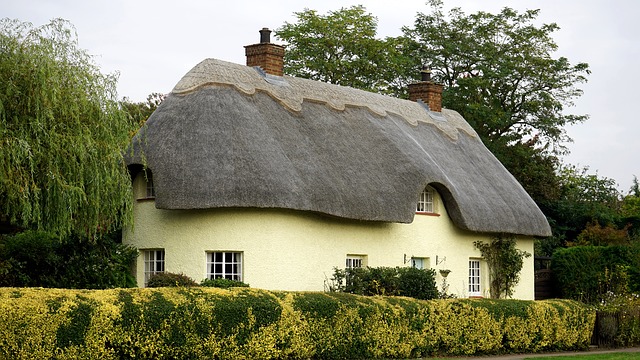Cottage
A cottage is a type of house, usually of a modest or small size and generally located in rural or semi-rural areas.
Originally, a cottage was a simple dwelling of a cotter (an agricultural labourer) in medieval England and Wales and was typically made up of ground floor living space (typically two rooms) and an upper floor of one or more rooms within the roof space. This was often describe as a ‘two up, two down’.
Cottages could be detached houses or terraced, as was the case with those built for workers in mining villages and other industrial areas. The windows were most commonly in mullion or casement style and the roof was very often thatched. They were usually built using post and beam construction which resulted in their characteristic low ceilings with exposed timber beams and earthen floors. Over time, the earthen floors were replaced with tiles set into a layer of sand.
Under Elizabethan-era statute, a cottage had to be built with at least 4 acres of land (a ‘small holding’). However, over the years the cottager’s right to hold land was removed by a number of Acts of Parliament, until the legal definition became a small house or habitation without land.
Cottages remain popular, often associated with small, rural villages. New build homes that resemble the look of traditional cottages may be called ‘mock cottages’.
[edit] Related articles on Designing Buildings Wiki
Featured articles and news
Government consultations for the summer of 2025
A year of Labour, past and present consultations on the environment, the built environment, training and tax.
CMA competitiveness probe of major housing developers
100 million affordable housing contributions committed with further consultation published.
Homes England supports Greencore Homes
42 new build affordable sustainable homes in Oxfordshire.
Zero carbon social housing: unlocking brownfield potential
Seven ZEDpod strategies for brownfield housing success.
CIOB report; a blueprint for SDGs and the built environment
Pairing the Sustainable Development Goals with projects.
Types, tests, standards and fires relating to external cladding
Brief descriptions with an extensive list of fires for review.
Latest Build UK Building Safety Regime explainer published
Key elements in one short, now updated document.
UKGBC launch the UK Climate Resilience Roadmap
First guidance of its kind on direct climate impacts for the built environment and how it can adapt.
CLC Health, Safety and Wellbeing Strategy 2025
Launched by the Minister for Industry to look at fatalities on site, improving mental health and other issues.
One of the most impressive Victorian architects. Book review.
Common Assessment Standard now with building safety
New CAS update now includes mandatory building safety questions.
RTPI leader to become new CIOB Chief Executive Officer
Dr Victoria Hills MRTPI, FICE to take over after Caroline Gumble’s departure.
Social and affordable housing, a long term plan for delivery
The “Delivering a Decade of Renewal for Social and Affordable Housing” strategy sets out future path.
A change to adoptive architecture
Effects of global weather warming on architectural detailing, material choice and human interaction.
The proposed publicly owned and backed subsidiary of Homes England, to facilitate new homes.
How big is the problem and what can we do to mitigate the effects?
Overheating guidance and tools for building designers
A number of cool guides to help with the heat.
The UK's Modern Industrial Strategy: A 10 year plan
Previous consultation criticism, current key elements and general support with some persisting reservations.
Building Safety Regulator reforms
New roles, new staff and a new fast track service pave the way for a single construction regulator.

























